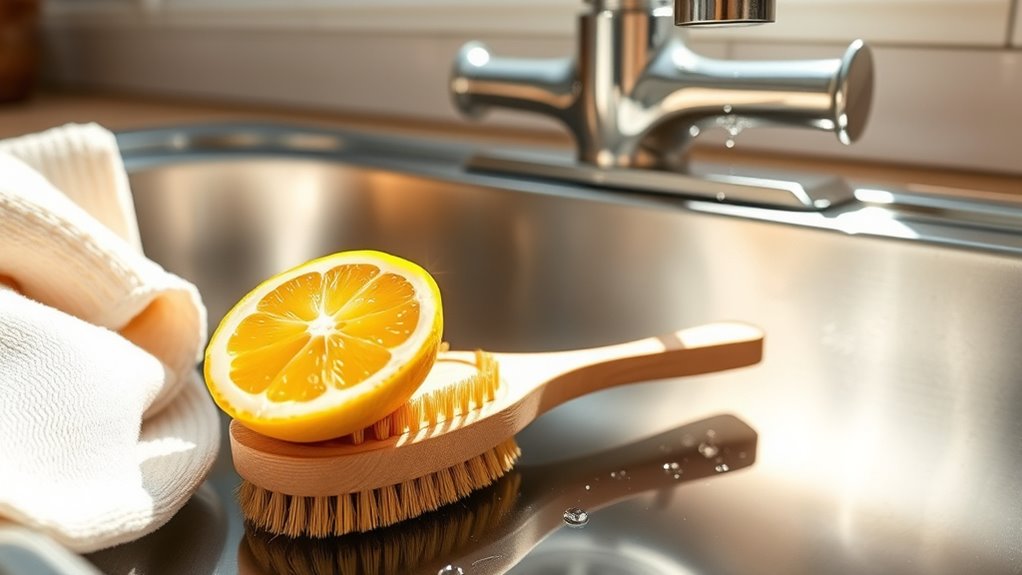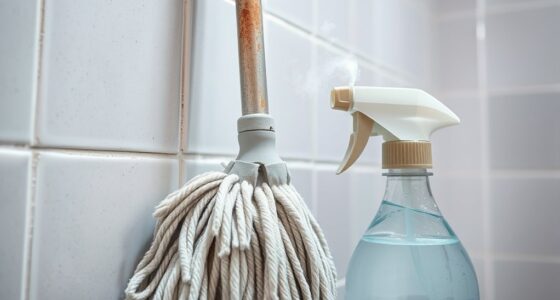The gem you’re overlooking in your kitchen is using natural, eco-friendly cleaning hacks that save time and reduce chemicals. Try polishing stainless steel with microfiber cloths and natural oils like olive or mineral oil for a streak-free shine. Use simple solutions like vinegar and water for versatile cleaning, and tackle tough stains with baking soda. Combining these methods creates a healthier, more sustainable space. Keep going to discover more smart tricks to transform your cleaning routine.
Key Takeaways
- Use microfiber cloths with natural oils like olive or mineral oil to effortlessly buff and polish stainless steel surfaces.
- Create a homemade cleaning spray with vinegar, water, and essential oils for an eco-friendly, versatile kitchen cleaner.
- Apply baking soda paste to stubborn stains, then buff with stainless steel tips for effective, chemical-free stain removal.
- Incorporate reusable cloths and natural oils to maintain a sparkling kitchen while reducing waste and harsh chemical use.
- Enhance kitchen hygiene by combining natural cleaning methods with HEPA air purifiers to improve overall air quality and surface cleanliness.

Ever wonder how to make cleaning easier and more effective? If so, then you might be overlooking a simple yet powerful trick tucked away in your kitchen. One of the best-kept secrets involves using stainless steel tips and eco-friendly solutions to tackle stubborn stains and grime. These tools and methods not only save you time but also help you reduce your environmental footprint, making your cleaning routine more sustainable and efficient.
Start by inspecting your stainless steel appliances—your fridge, sink, and oven. These surfaces often develop water spots, fingerprints, and smudges that can be stubborn to remove. Instead of reaching for harsh chemical cleaners, try using stainless steel tips to buff out fingerprints and restore shine. For example, a clean, dry microfiber cloth or a soft sponge combined with a little olive oil or mineral oil can work wonders. Simply apply a small amount to the cloth and gently polish the surface. The stainless steel tips help you achieve a streak-free, glossy finish without scratching the metal. Plus, these tips are eco-friendly solutions because they rely on natural oils and reusable cloths, reducing waste and chemical exposure.
Buff out fingerprints with microfiber cloth and natural oils for a streak-free stainless steel shine.
Another effective hack involves making your own cleaning solutions using common household ingredients, which are both eco-friendly and budget-friendly. Mix equal parts white vinegar and water in a spray bottle to create a versatile cleaner that works on stainless steel, countertops, and even glass. Add a few drops of essential oil, like lemon or tea tree, for a fresh scent. This solution cuts through grease and grime without the harsh chemicals found in commercial cleaners. When you use stainless steel tips to apply this mixture, you’ll find that cleaning becomes quicker and more thorough, with fewer streaks or residue left behind. Plus, it’s safe for your family and the environment.
For tougher spots, like burnt-on food or soap scum, consider using baking soda combined with water to form a paste. Apply with a soft cloth or sponge, and then buff with stainless steel tips to lift stains and restore shine. This method is gentle on surfaces and eco-friendly, avoiding abrasive chemicals that can harm the environment. Reusing old cloths and opting for natural solutions not only saves money but also aligns with a sustainable lifestyle.
Additionally, choosing HEPA filtration air purifiers can significantly improve indoor air quality by capturing small particles such as allergens, dust, and pet dander, helping create a healthier kitchen environment. Incorporating these simple tips into your routine transforms cleaning from a chore into a quick, eco-conscious task. Using stainless steel tips and eco-friendly solutions means you don’t need to rely on heavy-duty chemicals. Instead, you harness natural ingredients and gentle tools to keep your kitchen sparkling. With just a little effort and the right know-how, you’ll find that cleaning becomes less of a hassle and more of a satisfaction, all while protecting your home and the planet.
Frequently Asked Questions
Can Baking Soda Damage My Kitchen Surfaces?
Baking soda is generally safe for your kitchen surfaces when used properly, but you should consider baking soda safety to avoid potential damage. It’s a mild abrasive, so it can scratch delicate surfaces like glass or polished stone if scrubbed vigorously. To protect your kitchen surface durability, gently use baking soda and avoid prolonged contact on sensitive materials. When in doubt, test a small area first to prevent any damage.
How Often Should I Deep Clean Kitchen Appliances?
Think of your appliances as investments; neglecting them shortens their lifespan. You should deep clean your kitchen appliances at least once a month, especially areas prone to grime like ovens, refrigerators, and dishwashers. Regular cleaning boosts appliance longevity and keeps your kitchen hygienic. If you cook often or notice buildup, increase cleaning frequency. Staying consistent prevents issues, saving you money and hassle in the long run.
Are Natural Cleaning Hacks as Effective as Chemical Cleaners?
Yes, natural cleaning hacks can be just as effective as chemical cleaners if you choose the right DIY solutions. Eco-friendly options like vinegar, baking soda, and lemon tackle grease and stains without harsh chemicals. You often need a bit more elbow grease, but they’re safe, affordable, and environmentally friendly. With consistent use, you’ll find these natural hacks can keep your kitchen sparkling just as well as store-bought cleaners.
What’s the Best Way to Remove Stubborn Stains?
To remove stubborn stains, act quickly with effective stain removal cleaning tips. Dab the stain with a mixture of baking soda and water, then let it sit for 15 minutes. For tougher stains, apply a small amount of hydrogen peroxide or white vinegar directly to the area, and gently scrub with a soft brush. Consistency and patience are key, so keep at it until the stain lifts.
How Can I Prevent Mold in My Kitchen?
To prevent mold in your kitchen, guarantee proper ventilation by using exhaust fans or opening windows regularly. Apply mold-resistant paint on walls and ceilings, especially in high-moisture areas. Keep your kitchen dry by wiping down surfaces after cooking or cleaning, and fix any leaks promptly. Good airflow and moisture control are key, so stay vigilant and maintain a clean, ventilated space to stop mold from taking hold.
Conclusion
Don’t underestimate the power of overlooked kitchen gems; sometimes, the simplest hack can transform your space like a magician’s touch. By incorporating these tips, you’ll turn cleaning from a chore into a breeze, revealing a sparkling kitchen that feels fresh and inviting. Remember, the true treasure lies in the details you often ignore—those small, overlooked hacks that make a big difference. Embrace these secrets, and watch your kitchen shine brighter than ever before.









